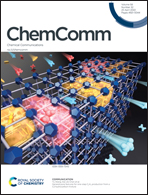An antioxidant boehmite amino-nanozyme able to disaggregate Huntington's inclusion bodies†
Abstract
A novel amino-nanozyme, based on boehmite nanoparticles (BNPs) functionalised with a tetra-azapyridinophane (L1), has been designed to undermine some of the key issues underlying Huntington disease. L1 forms Cu2+ complexes with a striking SOD activity, while when grafted to the BNPs displays mitoROS scavenging properties and ability to disaggregate mutant huntingtin deposits in cells.



 Please wait while we load your content...
Please wait while we load your content...